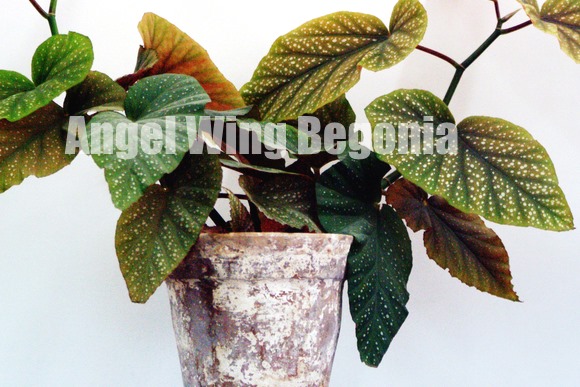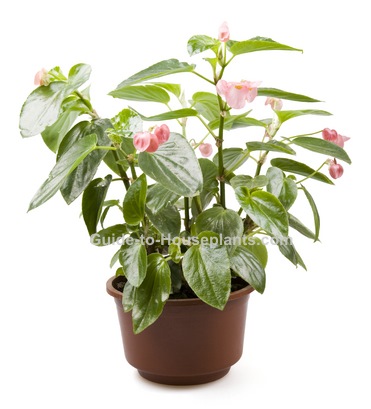Angel Wing Begonia
Angel wing begonia house plants are gorgeous year-round. Even when not in bloom, the elegantly shaped begonia leaves cascading down cane-like stems are beautiful. Often spotted with white, the big, glossy green leaves feature reddish undersides.
Here you'll discover care tips for growing angel wing begonias indoors, how to head off houseplant problems, plus suggestions for top angel begonia varieties.
 Angel Wings are beautiful, even without flowers. Put them on a pedestal stand to show them off.
Angel Wings are beautiful, even without flowers. Put them on a pedestal stand to show them off.Get to Know Your Angel Wing Begonia
Grown more for foliage than flowers, angel wings are among the most eye-catching houseplants you can grow. These beauties are evergreen, adding dazzling style to your home all year long.
The sprays of delicate flowers are just an added attraction. Bloom time is different for each variety, but most angel wing begonias flower in late winter or spring, with some giving a show of blooms several times throughout the year. Flower colors range from soft pink to coral to deep red.
Care is easy, too. This is one of the easiest begonias to grow indoors. Much less fussy about humidity than rex begonias, this member of the family is less challenging to grow.
Angel wing begonias are perennials and will last several years with good care. They do have a tendency to get leggy over time. It's a good idea to propagate your houseplant by taking stem cuttings (see "How to Propagate" below). It's an easy way to keep your collection going.
The begonia family owes its name to Frenchman Michel Begon. It includes more than 900 species and thousands more hybrids and cultivars.
How big do they get? Some angel wing begonias reach a height up to 3 ft (90 cm). Want a small table plant? Look for dwarf varieties that grow to 1 ft (30 cm) tall.
Angel wing begonia has origins in South America, but those grown and sold today are Begonia x corallina hybrids, producing bigger flowers and more of them.
There are many named varieties to choose. Among the best for growing indoors are 'Bubbles' -- a compact cultivar that blooms nearly year-round...colorful 'Cracklin Rosie' features reddish foliage spotted with rose-pink...'Looking Glass' has stunning silvery green leaves with red undersides.
Caring for Angel Wings Year-Round
Repot in spring. Move your plant up to a pot only 1 size larger. Angel wing begonias have fibrous roots and grow best when slightly pot-bound. Set the plant with its crown slightly above the soil line to prevent stem rot. Tamp down the soil gently with your fingers so that it doesn't pack too tightly -- begonias like a little air around their roots.
Don't overwater. This is probably the only common problem with growing begonias. Using a small pot with a drainage hole will help to prevent overwatering. Allow the soil to dry out slightly between waterings. The beautiful angel-winged leaves will let you know when the soil is too soggy by turning yellow and dropping off.
Watch for yellow halos on leaves. They're a sign of leaf spot -- a bacteria that grows in a moist, cool environment. Cut off affected leaves and be sure your plant has air circulation around it. However, keep it away from heat/AC vents.
Something bugging your begonia? Thrips, spider mites and mealybugs are attracted to houseplants. Treat any infestation right away.
Deadhead spent flowers. Cut off flowers after they dry up. Deadheading not only keeps your begonia good-looking, it encourages more blooms.
How to Propagate Angel Wing Begonias
Stem cuttings root easily. Spring or early summer is the best time to propagate angel wing begonias because they are beginning their most vigorous time of growth.
Cut off 3-4 inch (8-10 cm) non-flowering stem tip cuttings. Dip the cut ends in a small amount of rooting hormone powder, then stick them in a 4-inch (10 cm) pot of moist perlite. Keep cuttings at room temperature, in indirect sunlight, and lightly moist. Your new cutting should root in about 4 to 6 weeks.

Angel Wing Begonia Care Tips
Light: Give your angel begonia plenty of bright, indirect light. You'll get the best leaf color and more flowers this way.
Water: Water thoroughly, allowing the top 1 in (2.5 cm) of soil to dry out between waterings. Water sparingly in winter. Yellow leaves are a symptom of soggy soil.
Humidity: This (mostly) foliage-type begonia is tolerant of average room humidity. However, if the air in your home is dry, use a pebble tray or room humidifier to give it a boost. Grouping tropical plants such as begonias, ferns and orchids also helps to increase the moisture in the air around them. Misting begonias is not a good idea because it can promote powdery mildew and fungal diseases.
Temperature: Average room temperatures 65-75°F/18-24°C suit this tropical native year-round. Begonias are not cold-tolerant and can be damaged by temperatures below 55°F/13°C.
Soil: African violet potting mix
Fertilizer: Feed every 2 weeks in spring and summer with high-phosphorous liquid fertilizer diluted by half. Take care to fertilize when the soil is already moist to avoid fertilizer burn.


